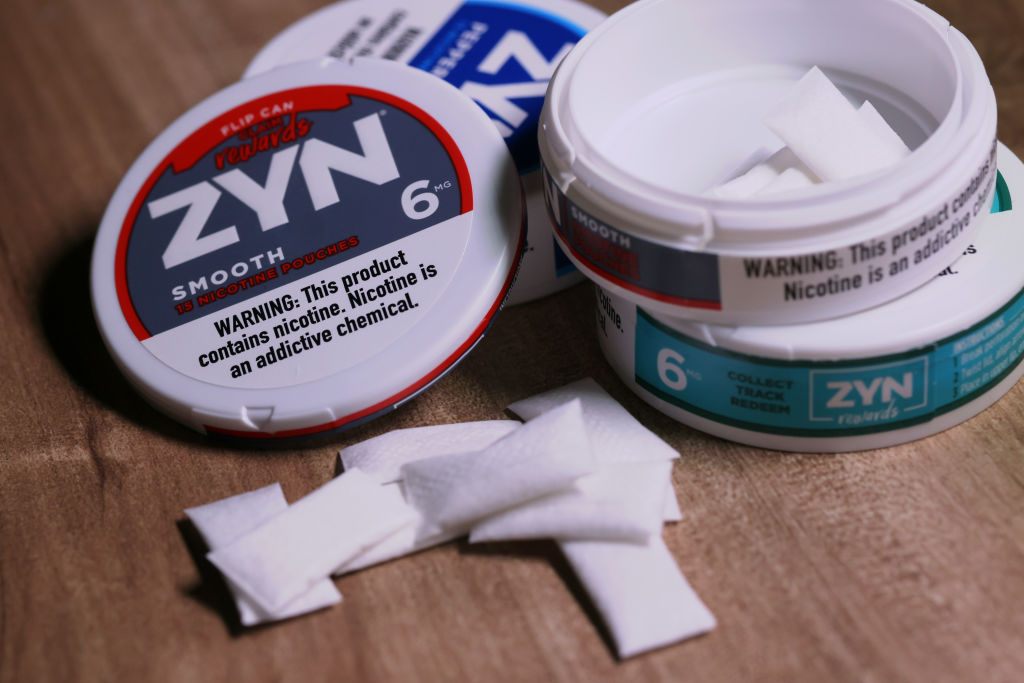
Not so long ago, Juul was seen as the new Marlboro. Smoking wasn’t that cool anymore—rates had plummeted among U.S. adults and teens—but then came Juul, a sleek, addictive product with flashy advertising tactics that took off like wildfire. It soon became clear that e-cigarettes were hooking teens who otherwise wouldn’t have gone near nicotine.
[time-brightcove not-tgx=”true”]Now, Juul is out and Zyn is in. It’s even more discreet than Juul, with no plumes of vapor. A user simply tucks a small pouch of nicotine, additives, and flavorings under their lip for up to an hour. Over that time, it releases a steady hit of nicotine—more than that in a cigarette, but delivered much more slowly. Like Juul, it contains no tobacco.
You’re not alone if you’re just hearing of Zyn, but it’s been for sale in the U.S. since 2014. Like other products that launched around that time, including Juul, it entered the market when the U.S. Food and Drug Administration (FDA) had few regulations for new tobacco and nicotine products. The agency retroactively required these brands to prove they benefit public health enough to stay on the market, and Zyn’s manufacturer has filed those applications, but the FDA hasn’t reached decisions yet.
A lack of regulatory oversight hasn’t stopped Zyn from becoming the latest product to lure people to a new and—at least seemingly—less-dangerous way to consume nicotine. “It’s a parallel world with what happened with e-cigarettes,” says Maciej Goniewicz, a nicotine and tobacco-control researcher at Roswell Park Comprehensive Cancer Center in New York.
Still, Zyn is nowhere close to as ubiquitous as Juul once was, according to the most recent available data. About 4.5% of U.S. adults vaped and 11.5% smoked in 2021, but only about 2% used smokeless tobacco products. And just 1.5% of U.S. teenagers regularly used nicotine pouches in 2022. (For context, at the height of Juul’s popularity in 2019, 27.5% of U.S. high schoolers vaped.) “It’s not an apples-to-apples comparison,” says Corey Henry, director of U.S. communications at Zyn’s parent company, Philip Morris International (PMI). “To be honest, it’s not even an apples-to-asteroids comparison.”
But oral nicotine products have picked up significant traction in recent years. The Federal Trade Commission recently reported that the category’s U.S. sales doubled from $453 million in 2020 to more than $1 billion in 2022. And Zyn’s U.S. business grew by 62% from 2022 to 2023 alone, according to an earnings report from PMI.
Zyn is also starting to go viral, which raises concerns about the product appealing to teens who might otherwise stay away from nicotine, says Dr. Robert Jackler, a tobacco advertising expert and professor emeritus at Stanford University. “The market for these pouches is rapidly growing, and it’s being driven by many attributes that would be attractive to young people in the way e-cigarettes such as Juul were,” Jackler says, including appealing flavors and advertising that makes users look attractive, active, and cool. “We’ve seen this playbook before,” he says.
There’s even a name for people who post about the pouches—Zynfluencers—prompting concern from some public-health officials and lawmakers. Senate Majority Leader Chuck Schumer recently called for a crackdown on products like Zyn, warning parents that companies “lock their sights on young kids—teenagers, and even lower—and then use the social media to hook ’em.”
Zyn does not hire influencers or use models younger than 35 in its ads, Henry says. It also bars anyone younger than 21 from accessing its website and flags social media posts that depict underage or dangerous use of Zyn to the platforms. But the company can’t “police the internet,” Henry says. Platforms including TikTok already prohibit posts that show or encourage underage drug, alcohol, or tobacco use, yet Henry says these policies don’t always catch everything.
Henry says PMI does everything required, and more, to prevent underage Zyn use. Its ads, he says, are meant to appeal to adult tobacco users looking to switch, not teenagers. The average Zyn user is 39 and previously used another tobacco or nicotine product, according to 2023 company research conducted among customers 21 and older.
Research on the safety of nicotine pouches is ongoing. But other oral products—including snus, which is similar to Zyn but contains tobacco instead of just nicotine—have been studied for decades and seem to present significantly lower risks of cancer and other diseases, relative to cigarettes. In 2019, the FDA allowed some snus products to be explicitly sold as lower-risk alternatives.
Based on what is currently known, Goniewicz, the nicotine researcher, says it’s safe to assume nicotine pouches don’t damage the lungs because users aren’t inhaling anything. Pouches also contain fewer of the cancer-causing chemicals found in traditional chewing tobacco, he says. Their biggest health risk for adult users, in his view, likely lies in nicotine’s potential to harm the cardiovascular system.
Products like these are also risky for oral health. “Anytime you park a foreign substance between your teeth and gums, you are taking a risk of dental problems,” such as cavities and gum disease, adds Jackler, who practiced for decades as an ear, nose, and throat physician.
Some researchers have raised additional concerns. One 2023 study found that oral nicotine products like Zyn contain low levels of potentially harmful substances, including ammonia and formaldehyde. And in a small 2024 study of adults who use nicotine pouches, almost all of them reported some kind of unpleasant side effect, including mouth lesions, nausea, and a sore throat or mouth. “They certainly seem to be safer than tobacco cigarettes,” says study co-author Ashley Dowd, a postdoctoral research fellow at Johns Hopkins University. “But having a general sense that they’re safe would concern me”—especially, she says, if it prompts people who don’t currently use nicotine to pick up a pouch thinking it’s harmless.
Dowd’s study also found that most pouch users continued to smoke or vape on the side. Another 2023 study found the same thing among users ages 15 to 24. Those findings suggest that some users can’t or don’t want to completely switch from smoking to using pouches—perhaps because they don’t deliver nicotine to the bloodstream rapidly enough to quell cravings, as some recent research hints. Using multiple nicotine products is concerning, Jackler says, since it can “deepen addiction and make continuing smoking more likely.”
But if people were to entirely quit cigarettes or vapes in favor of pouches, “as a physician, I would welcome that,” Jackler says. “On the other hand, I wish they never got addicted to begin with.”
























